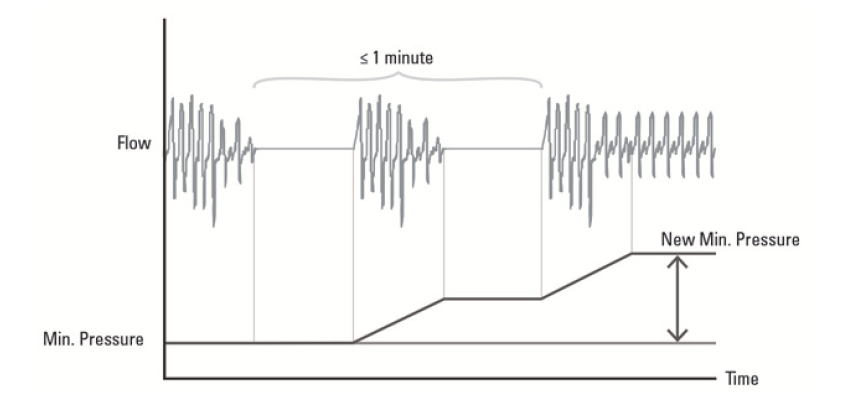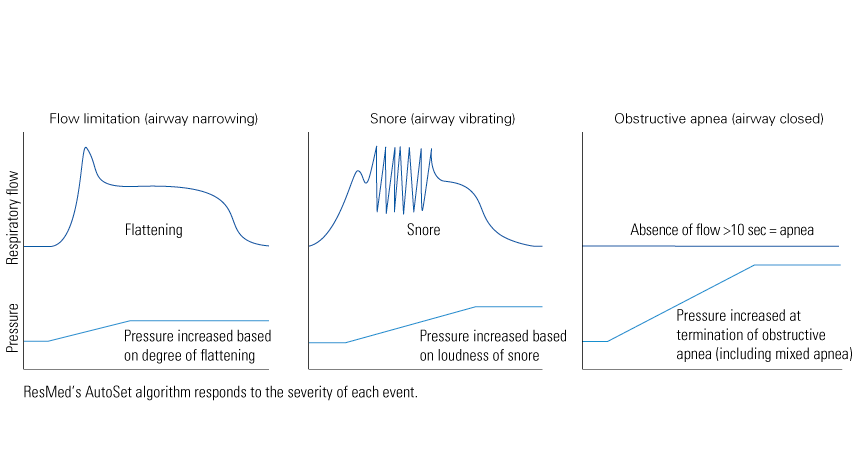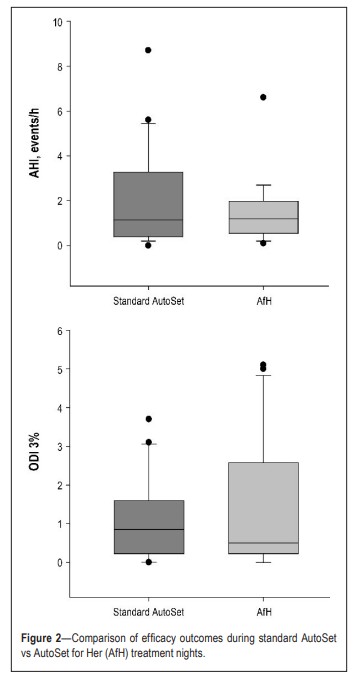CPAP Algorithms
Contents
AutoSet
AutoSet for Her
AutoSet for Her mode is based on key aspects of ResMed’s AutoSet algorithm and delivers therapeutic responses tailored to the characteristics of female OSA patients.
The AutoSet for Her is similar to ResMed’s AutoSet algorithm with the following modifications:
- Reduced rate of pressure increments designed to help prevent arousals.
- Slower pressure decays.
- Treats apneas up to 12 cm H2O and continues to respond to flow limitation and snore up to 20 cm H2O.
- Minimum pressure (Min. Pressure) that adjusts according to the frequency of apneas:
- If two apneas occur within a minute, the pressure reached in response to the second apnea will become the new minimum treatment pressure until the next treatment session.
Patients who use AutoSet for Her will still get the benefits of ResMed's AutoSet technology including improved sensitivity to flow-limitation and Central Sleep Apnoea Detection with ForcedOscillation Technique.
Algorithms - AutoSet for Her
The pioneering new algorithm in the AirSense™ 10 AutoSet for Her is based on ResMed’s proven AutoSet algorithm and delivers therapeutic responses that have been tailored to the characteristics of obstructive sleep apnea (OSA) in women.
Research has shown that women with OSA have more upper airway resistance and flow limitation than the general OSA population1, which is why the AutoSet for Her algorithm has been designed to be more sensitive to flow limitation.
In addition, the algorithm provides more subtle changes in therapy pressure to minimize sleep disturbance. The AutoSet for Her algorithm also automatically adjusts the minimum AutoSet pressure if multiple apneas are occurring below a certain threshold.
Algorithms - AutoSet
ResMed’s AutoSet algorithm continually monitors each patient’s unique breathing pattern on a breath-by-breath basis – every hour, every night.
When AutoSet detects an event, it doesn’t just apply a fixed pressure response. Instead, AutoSet assesses the severity of each event – whether it is flow limitation, snoring or an apnea – before determining and delivering the ideal, lowest pressure solution to treat the event.
Once the event is treated and the patient’s breathing stabilizes, AutoSet gradually decreases the pressure, while continuously monitoring for recurring events. Patients remain comfortable through it all, and receive the therapy pressure that is just right for treating their OSA – no more and no less.
Study of a Novel APAP Algorithm for the Treatment of Obstructive Sleep Apnea in Women
ResMed Corporation has recently developed a female-specific AutoSet for Her (AfH) algorithm; designed to optimize the pressure response to the specific patterns of obstructive sleep disordered breathing seen in women. The AfH algorithm is adapted from the S9 AutoSet algorithm (ResMed Ltd., Bella Vista, Sydney) with a number of modifications, including
- an increased sensitivity to flow limitation,
- The AfH algorithm has been designed to be more sensitive to flow limitation by responding to the first identified flow-limited breath rather than requiring three consecutive flow-limited breaths, as occurs with the standard AutoSet algorithm.
- an optimized internal gain (a slower, and lower, pressure rise and decay in response to flow limitation),
- the AfH algorithm increases pressure in response to flow limitation at a slower rate and to a lesser extent than the standard AutoSet algorithm (similarly the decay in the gain is lower).
- a lower cap on the pressure response to obstructive apneas,
- In order to prevent an excessive pressure rise, the AfH algorithm does not increase pressure above 12 cm H2O in response to detected apneas (but pressure can increase above 12 cm H2O if other respiratory events are present).
- an adaptive minimum pressure
- Another novel feature of the AfH algorithm is a moving minimum AutoSet pressure (i.e., a minimum pressure is set to which pressure decreases during sleep periods devoid of respiratory events). If apneas occur within a short time period the minimum AfH pressure will automatically increase and the pressure will not decline below this level for the remainder of the night’s therapy. The purpose of this is to minimize inappropriate pressure decreases during REM sleep that could occur with the standard AutoSet algorithm.
Conclusion: Among premenopausal women a novel female-specific autotitrating algorithm (AfH) is as effective as the standard AutoSet algorithm
in controlling obstructive sleep apnea (OSA). The new algorithm may reduce flow limitation more than the standard algorithm and achieve control
of OSA at a lower (95th centile) pressure.
Comparison of efficacy outcomes during standard AutoSet vs AutoSet for Her (AfH) treatment nights.
The Full Paper (2015) File:AutoSetForHer-2015-aasm.38.11.1775.pdf
The Link to the Original
https://academic.oup.com/sleep/article-pdf/38/11/1775/13690051/aasm.38.11.1775.pdf

Donate to Apnea Board



